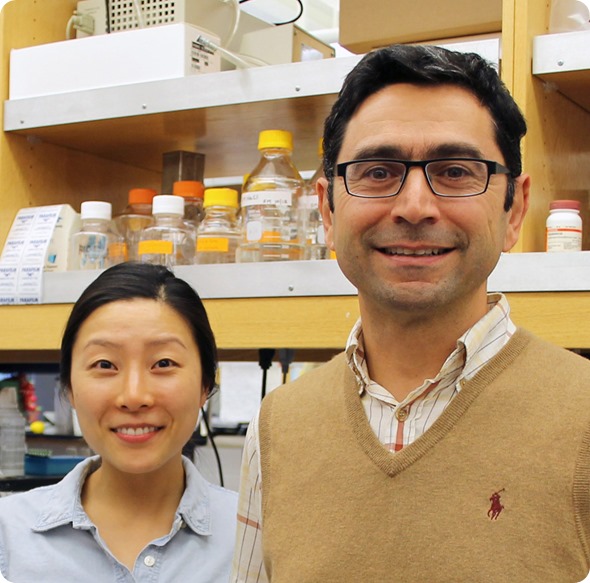Can you touch a finger to the tip of your nose with your eyes closed? Most of us can, thanks to a sense called proprioception, which tells us where our body parts are relative to each other and our environment. Not surprisingly, this sense is essential for normal movement and balance—walking, for instance.
For decades, biologists have been trying to find the crucial sensor protein in nerve endings that translates muscle and tendon stretching into proprioceptive nerve signals. Now in a study published in Nature Neuroscience on November 9, 2015, a team led by scientists from The Scripps Research Institute (TSRI) has identified this sensor protein in mice.
It turns out to be a protein called Piezo2, which was found recently to mediate the sense of touch.

The Scripps Research Institute’s Professor Ardem Patapoutian (right) and Research Associate Seung-Hyun Woo led the new study.
“To the layman it might not seem surprising that touch and proprioception would use the same sensor protein, but within this field there has been a lot of evidence suggesting otherwise—so finding that Piezo2 does both was a surprise.”
Lead investigator Ardem Patapoutian, professor at TSRI and investigator with Howard Hughes Medical Institute.
The laboratories of Thomas M. Jessell at Columbia University and Katherine A. Wilkinson at San Jose State University collaborated on the study.
Multi-Purpose Protein
Patapoutian and his laboratory specialize in identifying and characterizing sensory transducer proteins and over the past 15 years have identified transducers of cold, heat and pain. In two studies published last year, they identified Piezo2 as the principal sensor for ordinary, non-painful touch in mice.
The new findings stem in part from those studies, in which Patapoutian and his team developed transgenic mice that can be made to switch off Piezo2 activity in “touch” neurons and other sensory neurons based in the spine. With Piezo2 silenced, the mice showed profound deficits in responding to touch. But they also showed a different kind of deficit.
“Their walking was a bit abnormal, which gave us a hint that some proprioceptive neurons might be affected, too,” said Seung-Hyun Woo, a research associate in the Patapoutian laboratory who was first author of the new study.
In an initial set of experiments for the new study, the team managed to isolate mouse sensory neurons involved in proprioception and tested these neurons’ electrical responses to mild mechanical pressure. Such neurons’ nerve ends and cell bodies are known to be studded with mechanically activated ion channel proteins, which essentially spring open—admitting a surge of charged molecules (ions) and triggering an electrical nerve impulse—when the surrounding nerve or cell membrane is distorted sufficiently by a stretching of the local muscle tissue.
Prior studies had suggested that the main stretch-sensing protein expressed by proprioceptive neurons is one that specializes in admitting sodium ions. However, the team found evidence from these initial tests that the main ion-channel protein on proprioceptive neurons is not a selective sodium-channel protein, but in fact has properties consistent with Piezo2s.
The researchers then confirmed that Piezo2 is expressed in mouse proprioceptive neurons and their muscle-embedded nerve ends. To establish Piezo2’s role with more certainty, they developed two lines of transgenic mice in which Piezo2 production could be switched off in proprioceptive neurons shortly after the mice were born. The resulting animals showed severe abnormalities in walking and limb positioning.
“Their limbs were everywhere—they looked like they were trying to do yoga,” said Woo.
In a final set of experiments, the team found that leg muscle tissue from these mice lacking Piezo2—tissue with proprioceptive nerves embedded—produced almost no nerve signals in response to muscle stretching, whereas muscle tissue from normal mice produced robust signals.
“The data that we have now in support of Piezo2’s role in proprioception are really overwhelming,” said Patapoutian.
While the finding is a milestone in sensory neuroscience, it may also lead to a better understanding of some human diseases relating to proprioception. For example, a genetic disorder known as distal arthrogryposis type 5, whose sufferers are born with severely contracted joints, was found in 2013—by Patapoutian and colleagues—to be caused by a mutation to the human version of Piezo2.
The Patapoutian lab is continuing to investigate.
The other co-authors of the paper, “Piezo2 is the principal mechanotransduction channel for proprioception,” were Viktor Lukacs and Allain Francisco from TSRI, Joriene C de Nooij from Columbia University, and Dasha Zaytseva and Connor R. Criddle from San Jose State University.